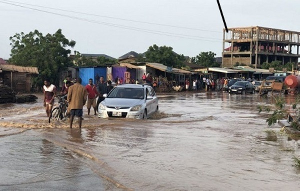The Ashanti Regional National Disaster Management Organisation (NADMO) is ramping up its efforts to prevent flooding ahead of the rainy season.
In 2024, flooding incidents in the Ashanti Region resulted in several lives being lost.
NADMO is now shifting its focus from disaster response to prevention.
According to a TV3 report, the organisation has identified multiple flood-prone communities, including Owabe, Aboabo Pelele, Akwatia Line, Sewaba, Aloga Junction, Breman UGC, and Kronom Abuohia.
Regional NADMO Director, Mohammed Nassir Ibrahim, outlined their strategy, stating that; “We are going to be able to desilt and drain the streams and gutters that are already choked, not just desilt, take the filth away so that it doesn’t go back in there.”
Ibrahim emphasised the importance of collaboration, stating; “Also, we are involving our assemblymen, sub-metros, traditional leaders, and all those who matter. So that in preparedness, we have contact with each other, and they can alert us on what needs to be done when we don’t have the power to collaborate. When we are empowered, we will deal with it.
“So, this year, we are hoping and praying that we get the necessary support to clear the streams and gutters, and to even prevent the flooding.”
He expressed hope for the necessary support to clear the streams and gutters and prevent flooding.
With the rainy season approaching, NADMO officials are working diligently to minimise the potential impacts of flooding.
To enhance their flood mitigation efforts, NADMO staff in the region are undergoing intensive training in disaster prevention techniques.
“Yes, we are NADMO, we have a duty imposed on us by law and by the state. But when the disaster strikes, it doesn’t select residents or travelers; it affects all of us,” the regional director remarked.
Through public education campaigns, desilting of drains, and community sensitisation programs, NADMO is proactively working to reduce flooding risks.
As the rains draw near, residents in high-risk areas are also taking precautions.
NAD/AE



